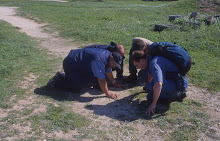The humped-back relationships proposed by Grime relates diversity and productivity in ecosystems and postulates that with increasing productivity there is first an increase of diversity and than, after a peak, a decrease at very high productivities. This hypothesis is based on the observation of herbaceous vegetation in temperate areas. The paper by Adler - Productivity Is a Poor Predictor of Plant Species Richness (Science 333,, 2011) compares a number of grasslands mainly in America with a few in other continents. The paper doesn’t find a pattern at the scale of the plot – but this doesn’t falsifies Grimes’ hypothesis that is concerned with diversity across ecosystems – and finds a significant humped backed relationship but with low explanatory power (r² = 0.11). I inspected the picture of the picture and I was surprised: there are 40 points before the peak and 2 points after the peak of the diversity-productivity relationship. Of course the explanatory power is low – the setis strongly unbalanced! Please revise the basics of regression – I often read excited debates about models so complicated that you can say practically everything about them and I didn’t read anything about this very simple bias (possibly beacuase of my inadequacy). If you interpret correctly the curve, the study supports Grime’s hypothesis. I suspect that the editor of Science noticed this, but a paper supporting Grime’s hypothesis would not be cited as frequently as a paper rejecting it.
Please take note that I think that humped backed relationship is probably false, not because we need to be mechanistic as is said in the conclusions of the paper or because nature is more complicated than claimed by Grime – when you say that a thing is complicated it means that you don’t understand it – but because we know almost nothing about the relationship between diversity and productivity in forests, where productivity is much more difficult to sample. The relationship in forests is probably linear (but the highest productiviiesy are lower than the peak in herbaceous communities), but nobody can say. There are a few very productive forests, for instance locust tree populations.
sabato 11 maggio 2013
Iscriviti a:
Commenti sul post (Atom)

Nessun commento:
Posta un commento